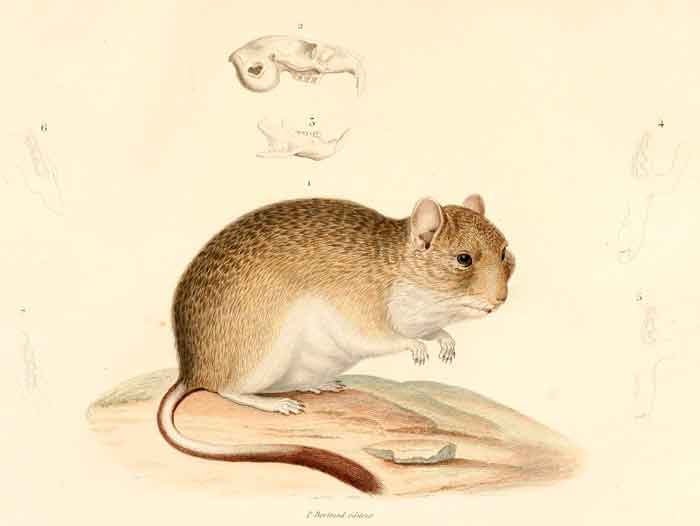
Superregnum: Eukaryota
Cladus: Unikonta
Cladus: Opisthokonta
Cladus: Holozoa
Regnum: Animalia
Subregnum: Eumetazoa
Cladus: Bilateria
Cladus: Nephrozoa
Superphylum: Deuterostomia
Phylum: Chordata
Subphylum: Vertebrata
Infraphylum: Gnathostomata
Megaclassis: Osteichthyes
Cladus: Sarcopterygii
Cladus: Rhipidistia
Cladus: Tetrapodomorpha
Cladus: Eotetrapodiformes
Cladus: Elpistostegalia
Superclassis: Tetrapoda
Cladus: Reptiliomorpha
Cladus: Amniota
Cladus: Synapsida
Cladus: Eupelycosauria
Cladus: Sphenacodontia
Cladus: Sphenacodontoidea
Cladus: Therapsida
Cladus: Theriodontia
Cladus: Cynodontia
Cladus: Eucynodontia
Cladus: Probainognathia
Cladus: Prozostrodontia
Cladus: Mammaliaformes
Classis: Mammalia
Subclassis: Trechnotheria
Infraclassis: Zatheria
Supercohors: Theria
Cohors: Eutheria
Infraclassis: Placentalia
Cladus: Boreoeutheria
Superordo: Euarchontoglires
Ordo: Rodentiaa
Subordo: Hystricomorpha
Infraordo: Hystricognathi
Parvordo: Caviomorpha
Superfamilia: Octodontoidea
Familia: Ctenomyidae
Genus: Ctenomys
Species: Ctenomys brasiliensis
Name
Ctenomys brasiliensiss Blainville, 1826
Vernacular names
References
Ctenomys brasiliensis in Mammal Species of the World.
Wilson, Don E. & Reeder, DeeAnn M. (Editors) 2005. Mammal Species of the World – A Taxonomic and Geographic Reference. Third edition. ISBN 0-8018-8221-4.
The Brazilian tuco-tuco (Ctenomys brasiliensis) is a tuco-tuco species.[2] It is found mainly in the state of Minas Gerais in southeastern Brazil,[3] though Charles Darwin mentions it during his trip through present-day Uruguay.[4]
Description
The Brazilian tuco-tuco has a reddish-brown coat color. The tail has short hairs covering it. It is the largest species of its genus. The head-body length is about 300 mm and the tail is relatively short.[3]
References
Bidau, C.; Lessa, E. & Ojeda, R. (2008). "Ctenomys brasiliensis". The IUCN Red List of Threatened Species. 2008. IUCN: e.T5800A11710439. doi:10.2305/IUCN.UK.2008.RLTS.T5800A11710439.en. Retrieved 11 January 2018.
Woods, C.A.; Kilpatrick, C.W. (2005). "Infraorder Hystricognathi". In Wilson, D.E.; Reeder, D.M (eds.). Mammal Species of the World: A Taxonomic and Geographic Reference (3rd ed.). Johns Hopkins University Press. p. 1562. ISBN 978-0-8018-8221-0. OCLC 62265494.
Fernandes, F. A., R. Fornel, and T. R. O. Freitas. 2012. Ctenomys brasiliensis Blainville (Rodentia: Ctenomyidae): clarifying the geographic placement of the type species of the genus Ctenomys. Zootaxa. 3272: 57-68
Darwin, Charles R. (1839), Narrative of the surveying voyages of His Majesty's Ships Adventure and Beagle between the years 1826 and 1836, describing their examination of the southern shores of South America, and the Beagle's circumnavigation of the globe. Journal and remarks. 1832-1836., London: Henry Colburn, p. 619
In page 58, Charles Darwin says "The Tucutuco (Ctenomys braziliensis) is a curious small animal, which may be briefly described as a Rodent, with the habits of a mole."
See it also in The Complete Work of Charles Darwin Online
Retrieved from "http://en.wikipedia.org/"
All text is available under the terms of the GNU Free Documentation License

